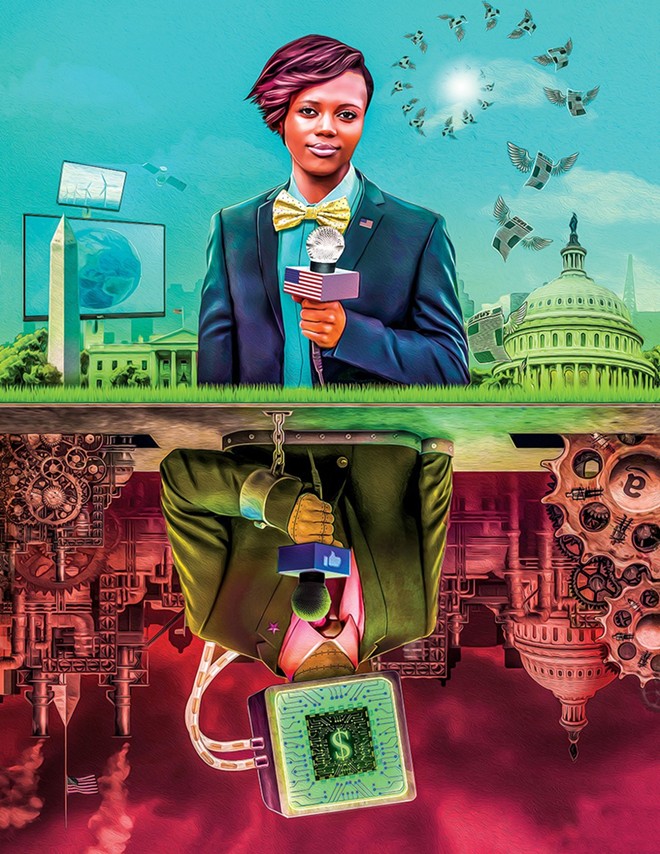Every year since 1976, Project Censored has performed an invaluable service — shedding light on the most significant news that's somehow not fit to print. Censorship in an authoritarian society is obvious, from a distance, at least. There is a central agent or agency responsible for it, and the lines are clearly drawn. That's not the case in America — yet some stories rarely, if ever, see the light of day, such as stories about violence against Native American women and girls, even though four out of five of them experience violence at some point in their lives, overwhelmingly at the hands of non-Native perpetrators.
"I wouldn't say that we're more vulnerable," Annita Lucchesi, a Southern Cheyenne descendant and executive director of the Sovereign Bodies Institute, told The Guardian. "I'd say that we're targeted. It's not about us being vulnerable victims, it's about the system being designed to target and marginalize our women."
And the media erasure of their stories is part of that same system of targeting and marginalization. While journalists everyday work hard to expose injustices, they work within a system where some injustices are so deeply baked in that stories exposing them are rarely told and even more rarely expanded upon to give them their proper due.
That's where Project Censored comes in.
"The primary purpose of Project Censored is to explore and publicize the extent of news censorship in our society by locating stories about significant issues of which the public should be aware, but is not, for a variety of reasons," wrote founder Carl Jensen on its 20th anniversary.
Thus, the list of censored stories that's the centerpiece of its annual book, State of the Free Press | 2021, doesn't just help us to see individual stories we might have otherwise missed. It helps us see patterns — patterns of censorship, of stories suppressed and patterns in how those stories fit together.
This year, for example, among its top 10 stories there are two stories about violence and victimization of women of color, including the role of media neglect: #1. Missing and Murdered Indigenous Women and Girls (introduced above) and #7. Underreporting of Missing and Victimized Black Women and Girls. There are similarities as well as differences between them, and being able to see them both together in Project Censored's list helps us see them both more fully as distinct, yet connected stories.
There are also three stories concerning the media itself (#2. Monsanto "Intelligence Center" Targeted Journalists and Activists, #6. Shadow Network of Conservative Outlets Emerges to Exploit Faith in Local News, and #10. Revive Journalism with a Stimulus Package and Public Option); there are two climate-change stories about overlooked causes and risks (#3. U.S. Military — A Massive, Hidden Contributor to Climate Crisis and #9. Rising Risks of Nuclear Power Due to Climate Change) while a third (#4. Congressional Investments and Conflicts of Interest) had a climate-change component — senators' fossil fuel investments; and two related to income inequality (#5. Inequality Kills: Gap between Richest and Poorest Americans Largest in 50 Years, about the problem itself and #8. The Public Banking Revolution, about a promising way to support a more equitable economy).
There are also further climate-change threads woven through these stories — a highlighted connection between the extractive fossil-fuel industry and violence against Native women, as well as an unmentioned connection via Monsanto's employment of FTI Consulting, which has been heavily involved in climate disinformation warfare.
The stories listed below are only part of what Project Censored does, however. State of the Free Press | 2021 has chapters devoted to other forms of obfuscation that help keep censored stories obscured. There's a chapter devoted to "Junk Food News," meaning cheaply produced stories focused on celebrityhood, industry-generated buzz, and other trivia in place of substantive investigative journalism, and another devoted to "News Abuse," meaning genuinely important topics presented through a distorted lens or two. There's also a chapter devoted to "Déjà Vu News," tracking previous Project Censored stories to update them and track whether they've gained some of the wider attention they deserve. And the chapter "Media Democracy in Action" highlights individuals and organizations engaged in building a more inclusive, equitable, and democratic society. So, if the Top 10 stories summarized below leave you hungry for more, Project Censored has all that and more waiting for you in State of the Free Press | 2021.


